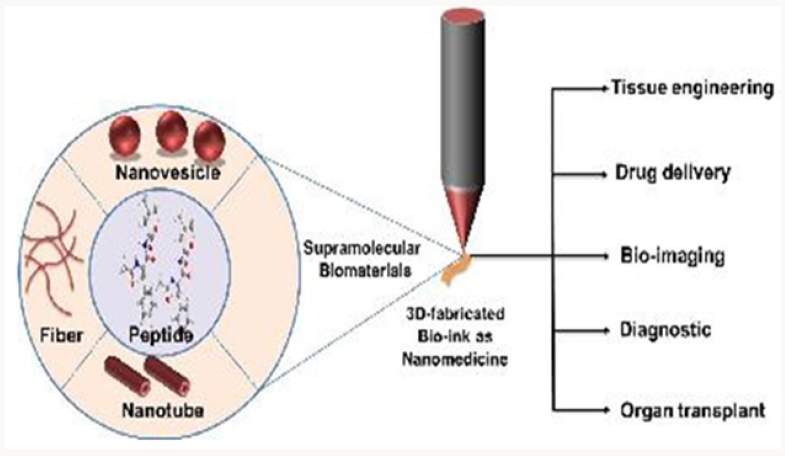Journal of Nanomedicine | Lupine Publishers
In the current era of research and development, nanotechnology and
additive manufacturing play a key role in the industry as
well as in the healthcare applications. In order to explore medicinal
applications, researchers focus on the design and synthesis
of biocompatible nanoparticles and nanomaterials. Molecular
self-assembly is a powerful approach for the fabrication of
supramolecular functional materials. Self-assembly offers the
integration of nanotechnology with the additive manufacturing for
the fabrication of three dimensional (3D) printed objects. The
cross-linked peptide hydrogels are gaining attention as potential bioink
for the 3D bio-fabrication. The current article focuses on the scope of
the printable peptide containing hydrogels as bio-ink in
the fields of nanomedicine, drug delivery and tissue engineering.
Introduction
Design and the development of smart nanostructures that can
diagnose and simultaneously cure the health problems are the
main goals of the nanomedicine. Self-assembling bio-compatible
functional nanomaterials and their therapeutic activity under
biological environment are the key steps in order to develop
effective nanomedicine. Among various approaches to fabricate
nanostructures, self-assembly offers to fabricate supramolecular
functional nanostructures from their individual building blocks.
Self-assembly process involves through bottom-up approach to
construct supramolecular nanostructures. The nanostructures
including nanofibers, nanovesicles and micelles are formed through
intra- and intermolecular covalent and non-covalent interactions.
Self-assembles nanostructures formed by bioactive materials can
be integrated with additive manufacturing for developing effective
nanomedicine. The layer-by-layer bio-fabrication methods are
introduced in healthcare due to their applications in 3D drug
delivery systems, matured tissue cultures and in-vitro organ
fabrications [1]. Fabrication of patient-specific therapeutic system
facilitates more personalized and beneficial medicinal results. 3D
printing allows low cost and rapid printing of biomaterials that are
composed of drug molecules as well as embedded living cells [2].
The application of printing technologies for nanomedicine requires
the development of suitable materials, which endure not only the
process itself but also help to keep the biological entities stable. 3D
bio-fabrication of nanomaterials is a favourable strategy over direct
3D fabrication at nanoscale resolutions (Figure 1). Running parallel
to nanomedicine and 3D printing technology, various types of
selfassembled
printable materials have been developed by researchers
for medicinal applications. Self-assembled high water containing
nanostructures and extra-cellular native environment mimicking
hydrogels are promising candidates for medicinal applications such
as drug delivery as well as tissue engineering. The development of
nanomedicine bio-fabrication has been less explored due to lack
of suitable bio-inks. A number of hydrogels have been introduced
by worldwide researchers using various natural and synthetic
molecules. Among them, self-assembling printable peptide
containing hydrogels are the promising biocompatible material
for healthcare applications. In order to avoid the premature
collapse of the printed structure, suitable bio-inks need to be
developed carefully. An ideal peptide bio-ink should compose
of supramolecular nanostructure with mechanical rigidity and
shape fidelity. Peptides have the ability to adopt specific structures
which can easily tune by amino acid sequences with tunable
physical and chemical properties. Peptides self-assembled through
various covalent and non-covalent interactions such as hydrogen
bonding, van der Waal forces to construct different nanostructures
including nanofibers, micelles and nanotubular structures. The
peptide nanostructures with high bioactivity provide controlled,
biomimetic environment for cells in regenerative medicine and
drug trapping sites for site-selective drug delivery.
Figure 1: Schematic representation of nanomedicine fabricated by integrating peptide self-assembly with 3D- bio-fabrication.

Printable peptides are promising candidates for regenerative
nanomedicines. Recently, Das reported injectable nanofibrous
self-assembled of Amoc (9-anthracenemethoxycarbonyl)-
capped dipeptide hydrogels. These nanofibrous hydrogels show
antibacterial property and promote cell proliferation of human
white blood cells [3]. The acylated peptide containing two to five
hydrophobic amino acids with polar C-terminal residue selfassembles
in 3D nanofibrous structure [4]. The reported peptides
undergo a remarkable structural transition under the influence of
salt and peptide concentrations in order to increase the stiffness of
hydrogels. These injectable nanofibrous peptide hydrogels further
encapsulate human umbilical vein endothelial cells to stimulate
blood vessel development. Incorporation of active biomolecules
such as DNA, RNA with the peptide is also an important strategy
to develop printable peptide-based regenerative nanomedicine.
A polypeptide - DNA conjugate forms in situ biocompatible
hydrogel bio-ink [5]. The resultant properties of polypeptide and
DNA components result in the hydrogel networks suitable for
viable and functional living cells under physiological conditions.
Mimicking in vivo environment by layer by layer neuronal cells in
three-dimensional models is difficult during in vitro brain model
development. The brain is an enormously complex organ, which
is structured into various regions of layered tissue. Lozano et al.
developed bio-ink by cross linking of RGD peptide with gellan
gum [6]. The resultant polypeptide polymer hydrogel shows
cross linked porous nanostructures which enable to encapsulate
and provide the supportive environment for primary cortical
neurons. Neural network formation in cell supportive matrix offers
the opportunity to provide prototype brain-like structures for
healthcare applications like understanding of brain injuries and
neurodegenerative diseases.
Conclusion
Sophisticated targeted drug delivery and regenerative
therapeutics have gained increasing attention during recent years.
In comparison with conventional drug delivery, 3D bio-fabrication
allows manufacturing of patient specific-drug delivery systems.
Above mentioned examples show the potential of printable peptidebased
hydrogel networks, which can resolve tissue engineering and
regenerative therapeutics problems. Few examples have shown
the printed 3D networks worth for antibacterial and microbial
activity. Development of new peptide-based materials and their
implementation in printable nanomedicine is the key challenges
to become the mainstream technology. 3D printed biomaterials
need to upgrade in order to achieve four-dimensional printing in
healthcare applications.
For
more
Lupine Publishers Open
Access Journals Please visit our website
https://lupinepublishersgroup.com/
For more
Journal of Nanomedicine articles Please Click Here:
https://lupinepublishers.com/nano-science-nano-technology-journal/
To Know more
Open Access Publishers Click on
Lupine Publishers


No comments:
Post a Comment
Note: only a member of this blog may post a comment.